International Trade Theory and Policy
Added on 2023-06-15
24 Pages4654 Words71 Views
Running head: INTERNATIONAL TRADE THEORY AND POLICY
International Trade Theory and Policy
Name of the Student:
Name of the University:
Author’s Note:
International Trade Theory and Policy
Name of the Student:
Name of the University:
Author’s Note:
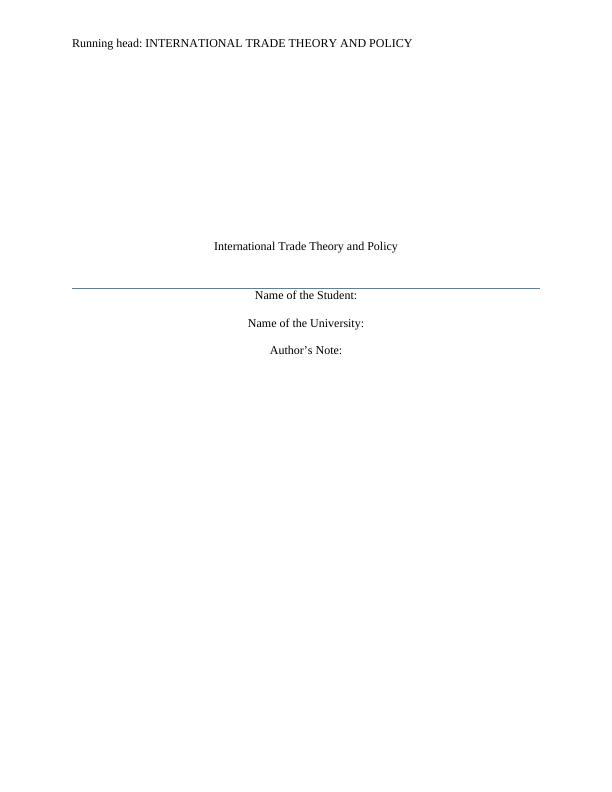
1INTERNATIONAL TRADE THEORY AND POLICY
Table of Contents
1.0 Introduction................................................................................................................................2
2.0 The Great Recession Period.......................................................................................................2
3.0 Recession and Weakening Global Economic Environment......................................................4
4.0 Increasing Vulnerability in Developing Countries....................................................................5
5.0 India during Global Economic Recession.................................................................................7
6.0 Great Recession and Trade Collapse of India............................................................................9
7.0 Impact of Recession on Major Sector of Trade.......................................................................13
8.0 Declining Global Trade and Industrial Production..................................................................14
9.0 Conclusion...............................................................................................................................19
Reference List................................................................................................................................20
Table of Contents
1.0 Introduction................................................................................................................................2
2.0 The Great Recession Period.......................................................................................................2
3.0 Recession and Weakening Global Economic Environment......................................................4
4.0 Increasing Vulnerability in Developing Countries....................................................................5
5.0 India during Global Economic Recession.................................................................................7
6.0 Great Recession and Trade Collapse of India............................................................................9
7.0 Impact of Recession on Major Sector of Trade.......................................................................13
8.0 Declining Global Trade and Industrial Production..................................................................14
9.0 Conclusion...............................................................................................................................19
Reference List................................................................................................................................20
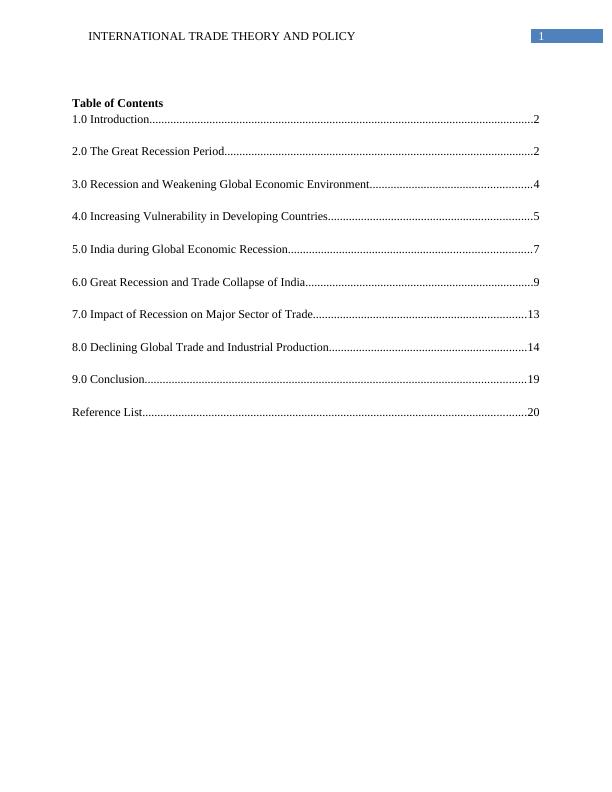
2INTERNATIONAL TRADE THEORY AND POLICY
1.0 Introduction
The world economy experienced the most severe financial shock during the period of
2008-2009. This period is actually known as great recession period. The result of great recession
was a great trade collapse, whereby the global trade declined severely in the beginning of 3rd
quarter of 2008 and 2nd quarter of 2009 (Eaton et al. 2016). The deepening global recession, high
volatility of commodity prices and rising unemployment of 2008-2009 severely impacted the
world trade performance level. Apart from that, declined global exports and imports, declined
global FDI inflow and outflow and declined consumer demand were directly responsible for the
declined world trade during the global recession period (Gawande, Hoekman and Cui 2014).
This study will discuss impact of current global recession on the world trade performance.
Moreover, the study will focus on India and the impact of global recession on the Indian trade
performance. The study will discuss the impact of global recession on the weakening global
economic recession. The increasing vulnerability of developing countries during the recession
period will also be discussed in this study. On the other hand, the study will highlight the impact
of global recession on the trade collapse of India. Furthermore, the study will demonstrate
declining global trade and industrial production during the recession period.
2.0 The Great Recession Period
The great recession was the period, when the world economy faced severe finical shock
during the late 2000s to 2010. Many economists have considered it as the most terrible economic
crisis since the great depression of 1930. In the beginning of 2007, a severe financial crisis
occurred in the subprime mortgage market in the United State (Lee and Gereffi 2015). Such
financial crisis had further developed into full-blown global banking crisis, which led to collapse
1.0 Introduction
The world economy experienced the most severe financial shock during the period of
2008-2009. This period is actually known as great recession period. The result of great recession
was a great trade collapse, whereby the global trade declined severely in the beginning of 3rd
quarter of 2008 and 2nd quarter of 2009 (Eaton et al. 2016). The deepening global recession, high
volatility of commodity prices and rising unemployment of 2008-2009 severely impacted the
world trade performance level. Apart from that, declined global exports and imports, declined
global FDI inflow and outflow and declined consumer demand were directly responsible for the
declined world trade during the global recession period (Gawande, Hoekman and Cui 2014).
This study will discuss impact of current global recession on the world trade performance.
Moreover, the study will focus on India and the impact of global recession on the Indian trade
performance. The study will discuss the impact of global recession on the weakening global
economic recession. The increasing vulnerability of developing countries during the recession
period will also be discussed in this study. On the other hand, the study will highlight the impact
of global recession on the trade collapse of India. Furthermore, the study will demonstrate
declining global trade and industrial production during the recession period.
2.0 The Great Recession Period
The great recession was the period, when the world economy faced severe finical shock
during the late 2000s to 2010. Many economists have considered it as the most terrible economic
crisis since the great depression of 1930. In the beginning of 2007, a severe financial crisis
occurred in the subprime mortgage market in the United State (Lee and Gereffi 2015). Such
financial crisis had further developed into full-blown global banking crisis, which led to collapse
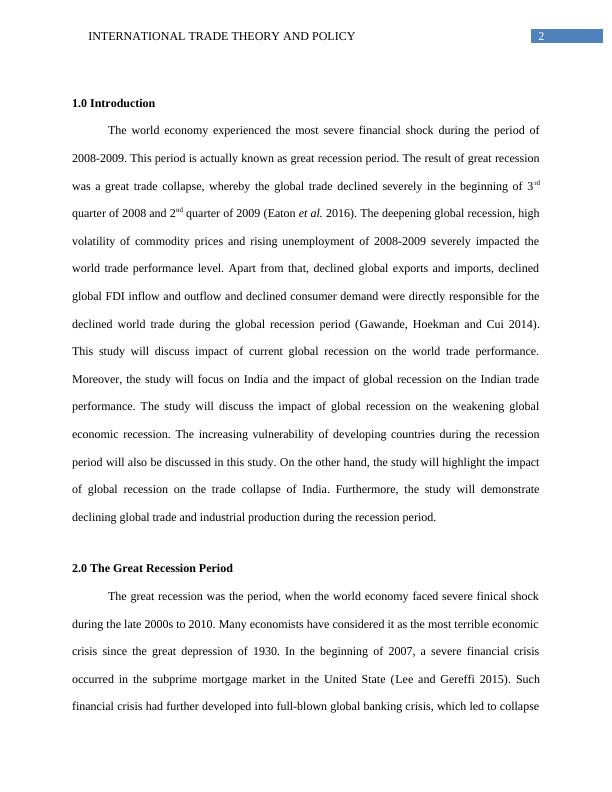
3INTERNATIONAL TRADE THEORY AND POLICY
of investment bank Lehman Brothers in 2008. According to Pentecôte and Rondeau (2015), the
Federal Reserve raised the interest rates for protecting the value of dollar. Such high interest rate
contributed a lot to the global recession. Sudden loss of confidence on investment and draining
of capital out of business led to stock market crash leading to great recession. On other hand,
Hong et al. (2017) opined that a slowdown in manufacturing of durable goods has led to
declining business progress leading to large scale of financial crisis. Apart from the, the credit
crunch and asset bubbles become inflated beyond their sustainable value, which led to large scale
of financial crisis.
The GDP of U.S had been fell down by 3.9% from its highest point, actual U.S import
fell by 18.6% and real U.S export declining by 15.2% during the period of recession. The
concomitant of great recession led to immense trade collapse, whereby the world trade had
declined fast during the period 2008-2009. World trade fell in line with economic magnitude like
GDP. Moreover, Gkanoutas-Leventis and Nesvetailova (2015) opined that global trade fell by
20% relative to global GDP.
of investment bank Lehman Brothers in 2008. According to Pentecôte and Rondeau (2015), the
Federal Reserve raised the interest rates for protecting the value of dollar. Such high interest rate
contributed a lot to the global recession. Sudden loss of confidence on investment and draining
of capital out of business led to stock market crash leading to great recession. On other hand,
Hong et al. (2017) opined that a slowdown in manufacturing of durable goods has led to
declining business progress leading to large scale of financial crisis. Apart from the, the credit
crunch and asset bubbles become inflated beyond their sustainable value, which led to large scale
of financial crisis.
The GDP of U.S had been fell down by 3.9% from its highest point, actual U.S import
fell by 18.6% and real U.S export declining by 15.2% during the period of recession. The
concomitant of great recession led to immense trade collapse, whereby the world trade had
declined fast during the period 2008-2009. World trade fell in line with economic magnitude like
GDP. Moreover, Gkanoutas-Leventis and Nesvetailova (2015) opined that global trade fell by
20% relative to global GDP.
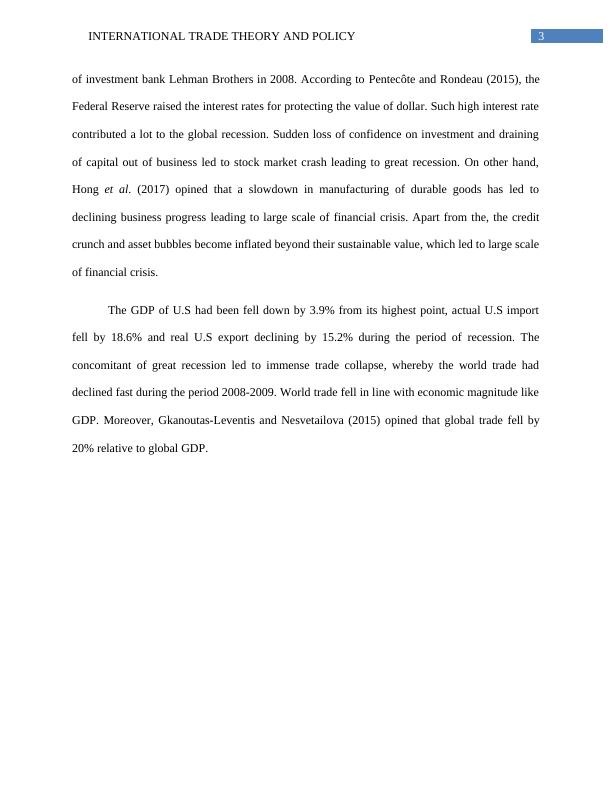
4INTERNATIONAL TRADE THEORY AND POLICY
Figure: Declining World Trade Relative to Global GDP
(Source: Heemskerk, Fennema and Carroll 2016)
In the year 2008-2009 great recession periods, the world trade fell down in real volume
by 12.2%. The significant price decline of the primary commodities like minerals and petroleum
was responsible for declining in dollar terms by 23%. Abiad, Mishra and Topalova (2014)
opined that the recession period of 2008 was also characterized by increased economic
downturn, increased unemployment, declined world trade and many more.
3.0 Recession and Weakening Global Economic Environment
The global economic downturn during 2008 recession period was much deeper than
expected and the recovery of such economic downturn would be gradual and highly uncertain.
According to Tyers (2016), during the second half of 2008, the world economy came to a halt on
Figure: Declining World Trade Relative to Global GDP
(Source: Heemskerk, Fennema and Carroll 2016)
In the year 2008-2009 great recession periods, the world trade fell down in real volume
by 12.2%. The significant price decline of the primary commodities like minerals and petroleum
was responsible for declining in dollar terms by 23%. Abiad, Mishra and Topalova (2014)
opined that the recession period of 2008 was also characterized by increased economic
downturn, increased unemployment, declined world trade and many more.
3.0 Recession and Weakening Global Economic Environment
The global economic downturn during 2008 recession period was much deeper than
expected and the recovery of such economic downturn would be gradual and highly uncertain.
According to Tyers (2016), during the second half of 2008, the world economy came to a halt on
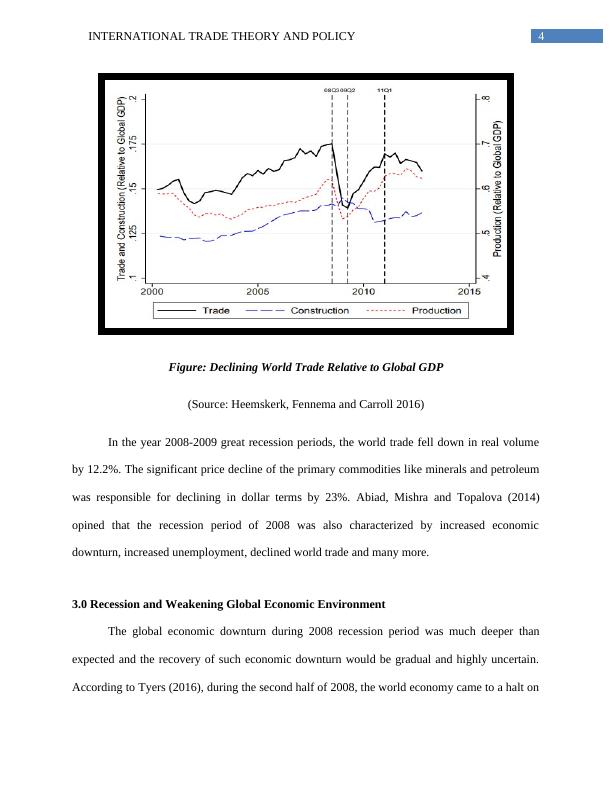
5INTERNATIONAL TRADE THEORY AND POLICY
annualized basis, where the global GDP slowed down by 2% after average growth of 5% over
the period 2003-2007. The flows of global trade collapsed in the 3rd quarter of 2008, where the
world export has been projected to decline in 2009.
Figure 2: World Trade in Goods and Services
(Source: Siteresources.worldbank.org 2009)
The contraction of economic activity had sharply been felt in advanced economies, with
lowest level of consumer and investor confidence in greater recession period. Drezner (2014)
opined that the bold actions of central banks and government in advanced economies facilitated
in mitigating the strains in interbank money market. However, such actions were insufficient for
addressing the wide interest spreads and reduced access to private sector credit. The damaging
feedback loops and of corporate sectors and household sectors led to undermining solvency of
banking sectors. The contradicting world trade, reduced market, declined domestic consumer
annualized basis, where the global GDP slowed down by 2% after average growth of 5% over
the period 2003-2007. The flows of global trade collapsed in the 3rd quarter of 2008, where the
world export has been projected to decline in 2009.
Figure 2: World Trade in Goods and Services
(Source: Siteresources.worldbank.org 2009)
The contraction of economic activity had sharply been felt in advanced economies, with
lowest level of consumer and investor confidence in greater recession period. Drezner (2014)
opined that the bold actions of central banks and government in advanced economies facilitated
in mitigating the strains in interbank money market. However, such actions were insufficient for
addressing the wide interest spreads and reduced access to private sector credit. The damaging
feedback loops and of corporate sectors and household sectors led to undermining solvency of
banking sectors. The contradicting world trade, reduced market, declined domestic consumer
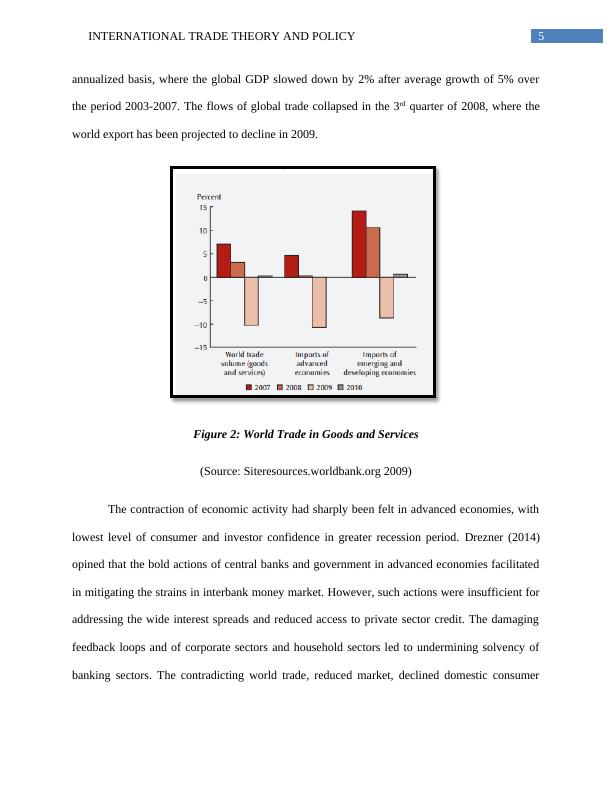
End of preview
Want to access all the pages? Upload your documents or become a member.
Related Documents
Impact of Global Recession on Trade Performance of Indialg...
|13
|1056
|250
Corporate Financial Management: Causes, Effects, and Reformslg...
|12
|2946
|332
Financial crisis 2008 causes and effects : Assignmentlg...
|14
|2893
|287
Global Financial Crisis PDFlg...
|14
|2798
|62
Global Financial Crisis Essaylg...
|10
|2717
|29
GFC in Pakistan and Other Countrieslg...
|13
|2914
|485
